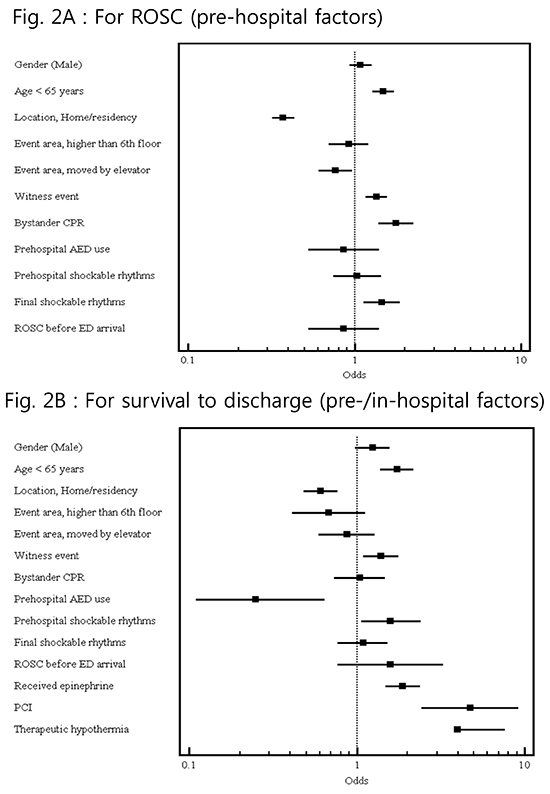1. Boyd TS, Perina DG. Out-of-hospital cardiac arrest. Emerg Med Clin North Am. 2012; 30:13–23.
2. Berdowski J, Berg RA, Tijssen JG, Koster RW. Global incidences of out-of-hospital cardiac arrest and survival rates: Systematic review of 67 prospective studies. Resuscitation. 2010; 81:1479–1487.
3. Sasson C, Rogers MA, Dahl J, Kellermann AL. Predictors of survival from out-of-hospital cardiac arrest: a systematic review and meta-analysis. Circ Cardiovasc Qual Outcomes. 2010; 3:63–81.
4. Lloyd-Jones D, Adams RJ, Brown TM, Carnethon M, Dai S, De Simone G, Ferguson TB, Ford E, Furie K, Gillespie C, et al. American Heart Association Statistics Committee and Stroke Statistics Subcommittee. Heart disease and stroke statistics: 2010 update: a report from the American Heart Association. Circulation. 2010; 121:e46–e215.
5. Go AS, Mozaffarian D, Roger VL, Benjamin EJ, Berry JD, Borden WB, Bravata DM, Dai S, Ford ES, Fox CS, et al. American Heart Association Statistics Committee and Stroke Statistics Subcommittee. Heart disease and stroke statistics: 2013 update: a report from the American Heart Association. Circulation. 2013; 127:e6–e245.
6. Ahn KO, Shin SD, Suh GJ, Cha WC, Song KJ, Kim SJ, Lee EJ, Ong ME. Epidemiology and outcomes from non-traumatic out-of-hospital cardiac arrest in Korea: a nationwide observational study. Resuscitation. 2010; 81:974–981.
7. Ro YS, Shin SD, Song KJ, Lee EJ, Kim JY, Ahn KO, Chung SP, Kim YT, Hong SO, Choi JA, et al. A trend in epidemiology and outcomes of out-of-hospital cardiac arrest by urbanization level: a nationwide observational study from 2006 to 2010 in South Korea. Resuscitation. 2013; 84:547–557.
8. Nichol G, Thomas E, Callaway CW, Hedges J, Powell JL, Aufderheide TP, Rea T, Lowe R, Brown T, Dreyer J, et al. Resuscitation Outcomes Consortium Investigators. Regional variation in out-of-hospital cardiac arrest incidence and outcome. JAMA. 2008; 300:1423–1431.
9. Brooks SC, Schmicker RH, Rea TD, Aufderheide TP, Davis DP, Morrison LJ, Sahni R, Sears GK, Griffiths DE, Sopko G, et al. ROC Investigators. Out-of-hospital cardiac arrest frequency and survival: evidence for temporal variability. Resuscitation. 2010; 81:175–181.
10. Atwood C, Eisenberg MS, Herlitz J, Rea TD. Incidence of EMS-treated out-of-hospital cardiac arrest in Europe. Resuscitation. 2005; 67:75–80.
11. Iwami T, Nichol G, Hiraide A, Hayashi Y, Nishiuchi T, Kajino K, Morita H, Yukioka H, Ikeuchi H, Sugimoto H, et al. Continuous improvements in "chain of survival" increased survival after out-of-hospital cardiac arrests: a large-scale population-based study. Circulation. 2009; 119:728–734.
12. National Emergency Department Information System data. accessed on 30 October 2012. Available at
http://edis.nemc.go.kr.
13. National Emergency Medical Center. 2009 Yearbook of emergency medical statistics. accessed on 30 October 2012. Available at
http://www.nemc.or.kr/.
14. Ko Y, Kim HJ, Cha ES, Kim J, Lee WJ. Emergency department visits due to pesticide poisoning in South Korea, 2006-2009. Clin Toxicol (Phila). 2012; 50:114–119.
15. McNally B, Robb R, Mehta M, Vellano K, Valderrama AL, Yoon PW, Sasson C, Crouch A, Perez AB, Merritt R, et al. Out-of-hospital cardiac arrest surveillance: Cardiac Arrest Registry to Enhance Survival (CARES), United States, October 1, 2005-December 31, 2010. MMWR Surveill Summ. 2011; 60:1–19.
16. Valderrama AL, Fang J, Merritt RK, Hong Y. Cardiac arrest patients in the emergency department-National Hospital Ambulatory Medical Care Survey, 2001-2007. Resuscitation. 2011; 82:1298–1301.
17. Zive D, Koprowicz K, Schmidt T, Stiell I, Sears G, Van Ottingham L, Idris A, Stephens S, Daya M. Centers for Disease Control and Prevention. Variation in out-of-hospital cardiac arrest resuscitation and transport practices in the Resuscitation Outcomes Consortium: ROC Epistry-Cardiac Arrest. Resuscitation. 2011; 82:277–284.
18. Glover BM, Brown SP, Morrison L, Davis D, Kudenchuk PJ, Van Ottingham L, Vaillancourt C, Cheskes S, Atkins DL, Dorian P. Resuscitation Outcomes Consortium Investigators. Wide variability in drug use in out-of-hospital cardiac arrest: a report from the resuscitation outcomes consortium. Resuscitation. 2012; 83:1324–1330.
19. Axelsson C, Claesson A, Engdahl J, Herlitz J, Hollenberg J, Lindqvist J, Rosenqvist M, Svensson L. Outcome after out-of-hospital cardiac arrest witnessed by EMS: changes over time and factors of importance for outcome in Sweden. Resuscitation. 2012; 83:1253–1258.
20. Adielsson A, Hollenberg J, Karlsson T, Lindqvist J, Lundin S, Silfverstolpe J, Svensson L, Herlitz J. Increase in survival and bystander CPR in out-of-hospital shockable arrhythmia: bystander CPR and female gender are predictors of improved outcome. Experiences from Sweden in an 18-year perspective. Heart. 2011; 97:1391–1396.
21. Lee MJ, Hwang SO, Cha KC, Cho GC, Yang HJ, Rho TH. Influence of nationwide policy on citizens' awareness and willingness to perform bystander cardiopulmonary resuscitation. Resuscitation. 2013; 84:889–894.
22. Na SH, Shin SD, Ro YS, Lee EJ, Song KJ, Park CB, Kim JY. Specific activity types at the time of event and outcomes of out-of-hospital cardiac arrest: a nationwide observational study. J Korean Med Sci. 2013; 28:320–327.
23. Shin SD, Suh GJ, Ahn KO, Song KJ. Cardiopulmonary resuscitation outcome of out-of-hospital cardiac arrest in low-volume versus high-volume emergency departments: An observational study and propensity score matching analysis. Resuscitation. 2011; 82:32–39.
24. Mader TJ, Nathanson BH, Millay S, Coute RA, Clapp M, McNally B. CARES Surveillance Group. Out-of-hospital cardiac arrest outcomes stratified by rhythm analysis. Resuscitation. 2012; 83:1358–1362.
25. Kim JY, Shin SD, Ro YS, Song KJ, Lee EJ, Park CB, Hwang SS. CardioVascular Disease Surveillance (CAVAS) investigators. Post-resuscitation care and outcomes of out-of-hospital cardiac arrest: a nationwide propensity score-matching analysis. Resuscitation. 2013; 84:1068–1077.
26. Lin S, Callaway CW, Shah PS, Wagner JD, Beyene J, Ziegler CP, Morrison LJ. Adrenaline for out-of-hospital cardiac arrest resuscitation: a systematic review and meta-analysis of randomized controlled trials. Resuscitation. 2014; 85:732–740.









 PDF
PDF ePub
ePub Citation
Citation Print
Print




 XML Download
XML Download